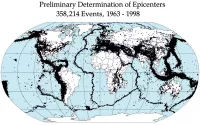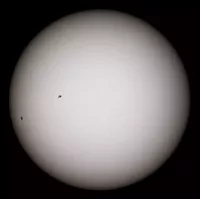A Moon landing is defined as the arrival of a spacecraft on the Moon's surface, encompassing both crewed and robotic missions. The Soviet Union's Luna 2 was the first human-made object to reach the Moon in 1959. These missions represent significant achievements in space exploration and technological advancement.
October 1957: Sputnik 1 Launch
In October 1957, the Soviet Union launched Sputnik 1, the first artificial satellite to orbit the Earth, initiating the Space Race.
1958: Start of US Uncrewed Lunar Missions
In 1958 the U.S. started the Pioneer and Ranger programs to reach the Moon with 15 consecutive uncrewed lunar missions failing their primary photographic missions.
1959: Luna 2 Reaches the Moon
In 1959, Luna 2 became the first human-made object to touch the Moon, marking a significant milestone in space exploration.
1959: Soviet Lunar Achievements
In 1959, the Soviet Union achieved the first escape from Earth's gravity, the first crash impact onto the Moon, and the first photography of the far side of the Moon with the Luna 1, Luna 2, and Luna 3 spacecraft.
1959: Soviet Union's First Hard Moon Landing
In 1959, the Soviet Union's Luna 2 spacecraft executed the first "hard" landing on the Moon by intentionally crashing into its surface at high speed.
1959: Soviets First Crash Landing on the Moon
In 1959, the Soviets successfully performed the first crash landing on the Moon.
1962: Failed Ranger Landing Attempts
In 1962 the Ranger landing attempts failed, using ballistic impacts, speeds of 160-kilometre-per-hour.
1962: First Moon Landing Attempt Missions
In 1962, Rangers 3, 4 and 5 missions by the United States attempted to land on the moon. The lander was designed to provide impact cushioning using an exterior blanket of crushable balsa wood and an interior filled with incompressible liquid freon.
1962: U.S. Duplicates Hard Landing
In 1962, the United States duplicated the Soviet Union's hard landing feat with the Ranger 4 spacecraft.
1962: U.S. Attempts to Hard Land Seismometer Packages
In 1962, three U.S. missions attempted to hard land small seismometer packages, but unlike the parent vehicle which was designed to deliberately crash onto the surface, these surface packages were designed to use retrorockets to survive landing.
1964: US Uncrewed Missions Conclude
In 1964 Rangers 4 and 6 successfully repeated the Soviet lunar impacts as part of their secondary missions, concluding 15 failed primary photographic missions by US.
1964: Block III Probes Missions for Apollo Landing Site Selection
In 1964, Block III probes replaced the Block II landing capsule with a heavier, more capable television system to support landing site selection for upcoming Apollo crewed Moon landing missions.
1965: National Turning Point Ranger 7
In 1965, Breaking the six-year string of failures in U.S. attempts to photograph the Moon at close range, the Ranger 7 mission was viewed as a national turning point, and instrumental in allowing the key NASA budget to pass intact.
February 1966: Luna 9 First Successful Soft Moon Landing
On 3 February 1966, the Luna 9 spacecraft, launched by the Soviet Union, performed the first successful soft Moon landing. Airbags protected its ejectable capsule which survived an impact speed of over 15 metres per second.
December 1966: Luna 13 Duplicates Soft Moon Landing
On 24 December 1966, Luna 13 duplicated the feat of soft landing on the moon with a similar design, and both Luna 9 and Luna 13 returned panoramic photographs that were the first views from the lunar surface.
1966: Missions Featuring Lunar Orbit
Beginning in mid-1966 both the U.S. and U.S.S.R. progressed into missions featuring lunar orbit as a prerequisite to a crewed Moon landing to select crewed landing sites.
1966: First Soft Landings and Lunar Pictures
In 1966, the Soviet Union's Luna 9 and Luna 13 missions achieved the first soft landings and captured the first pictures from the lunar surface.
1966: First Soft Lunar Landing by the U.S.
In 1966, the U.S. achieved its first uncrewed soft lunar landing, months after the Soviets achieved the milestone of a hard lunar landing with a ruggedized camera.
1966: Moon Landings by Soviet Union and US
In early 1966 both the Soviet Union and the United States had accomplished successful Moon landings with uncrewed spacecraft, showing roughly equal technical capabilities and returning images from the surface.
1966: US Begins Pulling Ahead in Space Race
In mid-1966 the United States had begun to pull ahead of the Soviet Union in the Space Race to land a man on the Moon due to the Surveyor 1 soft landing.
July 1969: Apollo 11 Moon Landing
In July 1969, Neil Armstrong and Buzz Aldrin landed on the Moon as part of the Apollo 11 mission, marking a pivotal moment in space exploration.
1969: Apollo 11 First Crewed Landing
In 1969, Apollo 11 achieved the first crewed mission to land on the Moon, a monumental achievement in human history.
1970: Lunokhod 1 Rover Delivered to Moon
In 1970, Lunokhod 1 ('Moonwalker') robotic lunar rover was delivered to the Moon, operating successfully for 10 months and covering 10.5km.
December 1972: Last Apollo Departure
In December 1972, the last crewed Apollo mission departed from the lunar surface, concluding a series of six crewed landings.
December 1972: Apollo 17 Mission Ends
On 14 December 1972, Gene Cernan and Harrison Schmitt concluded the Apollo 17 mission, with Cernan being the last man to step off the lunar surface.
1972: Luna 20 Sample Return Mission
In 1972, the Luna 20 successfully repeated the lunar sample return mission.
1973: Lunokhod 2 Rover Delivered to Moon
In 1973, Lunokhod 2 ('Moonwalker') robotic lunar rover was delivered to the Moon, operating successfully for 4 months and covering 37km.
August 1976: Luna 24 soft landing
On 22 August 1976 Luna 24 performed a soft landing on the Moon. Chang'e 3's landing in December 2013 was the first soft landing since this event.
1976: Luna 24 Mission
In 1976, the Luna 24 mission took place, marking a pause in soft landings on the Moon until 2013.
1976: Luna 24 Sample Return Mission
In 1976, the Luna 24 successfully repeated the lunar sample return mission.
1989: Phobos 2 came close to landing on Phobos
In 1989, the Soviet probe Phobos 2 came within 190 km of performing a landing on Mars' moon Phobos before radio contact was lost.
1991: Release of Soviet Lunar Records
After the fall of the Soviet Union in 1991, historical records were released, revealing the true accounting of Soviet lunar efforts and their mission numbering policy.
2005: Huygens probe landed on Titan
In 2005, the Huygens probe of the Cassini–Huygens mission to Saturn performed a successful moon landing on Titan.
November 2011: Fobos-Grunt stalled in low Earth orbit
In November 2011, the Russian sample return mission Fobos-Grunt launched but stalled in low Earth orbit.
2011: SpaceIL conceived to pursue Google Lunar X Prize
In 2011, SpaceIL was initially conceived as a venture to participate in the Google Lunar X Prize competition.
December 2013: Chang'e 3 soft-landed a rover on the Moon
On 14 December 2013, Chang'e 3 achieved China's first soft landing on another celestial body, specifically landing a rover on the Moon. This event marked the world's first lunar soft landing since 1976. The mission launched on 1 December 2013, and following the successful landing, the lander deployed the Yutu rover.
2013: Chang'e 3 Soft Landing
In 2013, Chang'e 3 achieved a soft landing on the Moon, resuming lunar landings after a long hiatus.
2013: China's Chang'e Program
Since 2013, China's ongoing "Chang'e" program has achieved multiple lunar landings, including robotic soil sample returns and the first landing on the far side of the Moon.
July 2016: Yutu rover was still operational
In July 2016 the Yutu rover was still operational, even after being immobilized due to system malfunction.
December 2017: Space Policy Directive 1
On 11 December 2017, US President Donald Trump signed Space Policy Directive 1, directing NASA to return to the Moon with a crewed mission.
January 2019: Chang'e 4 Far Side Landing
In January 2019, Chang'e 4 made history by performing the first landing on the far side of the Moon, expanding lunar exploration.
January 2019: Chang'e 4 landed on the far side of the Moon
On 3 January 2019, Chang'e 4 achieved the historic first landing on the far side of the Moon. The Chang'e 4 lander deployed the Yutu-2 rover and began human's first close exploration of the far side of the Moon.
February 2019: SpaceIL launched Beresheet spacecraft
On 22 February 2019, SpaceIL launched its Beresheet spacecraft from Cape Canaveral, Florida, aiming for a soft landing on the Moon.
March 2019: Announcement of first female lunar astronaut
On 26 March 2019, Vice President Mike Pence announced that the crewed mission will include the first female lunar astronaut.
April 2019: SpaceIL lost contact with Beresheet spacecraft and crashed
On 11 April 2019, SpaceIL lost contact with the Beresheet spacecraft during its final descent, leading to a crash due to a main engine failure.
July 2019: ISRO launched Chandrayaan-2
On 22 July 2019, ISRO launched Chandrayaan-2, consisting of an orbiter, lander, and rover, each equipped with scientific instruments.
September 2019: Contact lost with Vikram lander and crashed
On 7 September 2019, contact was lost with the Vikram lander at an altitude of 2.1 km during its braking phase, later confirming it had crashed.
2019: SpaceIL's Beresheet Failed Landing
In 2019, Israeli private space agency SpaceIL's Beresheet spacecraft attempted but failed to achieve a soft landing on the Moon.
December 2020: Chang'e 5 landed and returned lunar soil samples
On 6 December 2020, Chang'e 5 successfully landed on the Moon, collected lunar soil samples, and initiated the return journey to Earth. On 16 December 2020, the returner successfully landed in Inner Mongolia, completing China's first extraterrestrial sample return mission.
July 2022: Yutu-2 survived over 1000 days on the lunar surface
As of July 2022, the Yutu-2 rover had survived more than 1000 days on the lunar surface, traversing a cumulative distance of over 1200 meters.
July 2023: Chandrayaan-3 launched
On 14 July 2023, India's ISRO launched Chandrayaan-3, consisting of a Lander Module, Propulsion Module, and the Pragyan rover, setting course for the Moon.
August 2023: Luna 25 spacecraft failed and crashed
On 19 August 2023, Russia's Luna 25 spacecraft failed during pre-landing maneuvers and crashed into the lunar surface.
August 2023: Chandrayaan-3 landed near lunar south pole
On 23 August 2023, the Chandrayaan-3 lander successfully landed near the lunar south pole.
August 2023: India Lands on the Lunar South Pole
On August 23, 2023, ISRO's Chandrayaan-3 successfully landed its module in the lunar south pole region, making India the fourth nation to achieve a soft landing on the Moon.
September 2023: JAXA launched the SLIM mission
On 6 September 2023, JAXA launched the Smart Lander for Investigating Moon (SLIM) mission.
2023: ispace's Hakuto-R Mission 1 Failed Landing
In 2023, Japanese company ispace's Hakuto-R Mission 1 attempted but failed to achieve a soft landing on the Moon.
January 2024: Japan Lands on the Moon
On 19 January 2024, JAXA successfully landed its SLIM lander, making Japan the fifth nation to successfully complete a soft landing.
February 2024: Intuitive Machine's Odysseus landed on the Moon
On 22 February 2024, Intuitive Machine's Odysseus successfully landed on the Moon, marking the first soft unmanned Moon landing by the United States in over 50 years. This mission was a collaboration between NASA, SpaceX, and Intuitive Machines and represents the first privately owned spacecraft to land on the Moon and the first landing using cryogenic propellants. It tilted 18° upon landing due to a broken leg.
February 2024: Odysseus Lands on the Moon
On 22 February 2024, Intuitive Machine's Odysseus successfully landed on the Moon. This event marked the first successful landing of a privately owned spacecraft on the Moon.
May 2024: China sent Chang'e 6
On 3 May 2024, China sent Chang'e 6, which conducted the first lunar sample return from Apollo Basin on the far side of the Moon.
June 2024: Chang'e 6 landed on the Moon's surface
On 1 June 2024, the lander-ascender-rover combination separated before landing on the Moon's surface. On 25 June 2024, the returner landed on Inner Mongolia, completing China's far side extraterrestrial sample return mission.
2024: Original target date for crewed mission
The Artemis program had originally intended to land a crewed mission on the Moon in 2024.
January 2025: Hakuto-R Mission 2 launched
On 15 January 2025, the Hakuto-R Mission 2, carrying the RESILIENCE lunar lander and TENACIOUS micro rover, was launched on a Falcon 9 launch vehicle with Blue Ghost M1 lander.
March 2025: Firefly Aerospace's lunar landing is expected
In March 2025, Firefly Aerospace's lunar landing is expected on Mare Crisium.
June 2025: Hakuto-R Mission 2 landing expected
Around May-June 2025, the Hakuto-R Mission 2 landing is expected in Mare Frigoris.
2025: Chinese Lunar Exploration Program
Between 2025 and 2028, the Chinese Lunar Exploration Program plans 3 additional Chang'e uncrewed missions in active preparation for the International Lunar Research Station.
2025: Lunar Polar Exploration Mission
In 2025, the Lunar Polar Exploration Mission is expected to take place, it is a robotic space mission concept by ISRO and JAXA to explore the south pole region of the Moon.
September 2026: NASA lunar landing mission has been postponed
NASA's lunar landing mission has been postponed to launch no earlier than September 2026.
2027: Luna 26 launch planned
In 2027, Russia's Roscosmos plans to launch a lunar polar orbiter as Luna 26.
2028: Chinese Lunar Exploration Program
Between 2025 and 2028, the Chinese Lunar Exploration Program plans 3 additional Chang'e uncrewed missions in active preparation for the International Lunar Research Station.
2028: Chandrayaan 4
By late 2028, ISRO plans to launch Chandrayaan 4, a lunar sample return mission that would possibly be the first to return soil from the water rich south polar basin.
2028: Original target date for sustained operations
The Artemis program had intended to begin sustained operations by 2028.
2029: China Manned Space Agency intends to conduct crewed lunar landings
By 2029 or 2030, the China Manned Space Agency intends to conduct crewed lunar landings.
2030: China Manned Space Agency intends to conduct crewed lunar landings
By 2029 or 2030, the China Manned Space Agency intends to conduct crewed lunar landings.
Mentioned in this timeline

Donald John Trump is an American politician media personality and...

SpaceX founded in is a private American aerospace manufacturer and...

Google LLC is a multinational technology company specializing in online...
The Union of Soviet Socialist Republics USSR existed from to...
India officially the Republic of India is a South Asian...

Buzz Aldrin is an American former astronaut engineer and fighter...
Trending

2 months ago Kaitlan Collins Praises Karoline Leavitt; CNN to Host AOC and Sanders Town Hall

7 days ago Earthquake Rattles Northern California on Thanksgiving: Santa Rosa Area Sees 3.3 Magnitude

2 days ago Below Deck's Fraser Olender Suffered Heart Attack Due to Vaping at the Age of 33

Tim Walz is an American politician educator and Army National Guard veteran currently serving as the st Governor of Minnesota...
8 days ago Anthropic CEO to testify on Chinese AI cyberattack; Chatbots becoming criminals.
11 days ago Exploring David Simon's The Wire: A Masterpiece of Television and Social Commentary
Popular
Matt and Ross Duffer known as the Duffer Brothers are...
Aftyn Alyssa Behn is an American politician currently serving as...

Candace Owens is an American conservative political commentator and author...

XXXTentacion born Jahseh Dwayne Ricardo Onfroy was a controversial yet...

Ilhan Omar is an American politician currently serving as the...

Harriet Tubman was a pivotal American abolitionist and social activist...